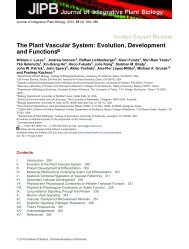New species of Solanum and Capsicum (Solanaceae) from Bolivia ...
New species of Solanum and Capsicum (Solanaceae) from Bolivia ...
New species of Solanum and Capsicum (Solanaceae) from Bolivia ...
You also want an ePaper? Increase the reach of your titles
YUMPU automatically turns print PDFs into web optimized ePapers that Google loves.
2006] nee et al.: solanum <strong>and</strong> capsicum (solanaceae) 355<br />
green when immature, the color when fully<br />
ripe unknown, glabrous. Seeds numerous (ca.<br />
120 per fruit), ca. 2 × 1.6 mm, flattenedreniform,<br />
yellow-brown, the surface minutely<br />
foveolate.<br />
Distribution.—Andean slopes in western<br />
<strong>and</strong> central <strong>Bolivia</strong> in Departments <strong>of</strong><br />
Cochabamba <strong>and</strong> La Paz at 1800–3000 m elevation.<br />
Phenology.—Flowering in May, September,<br />
<strong>and</strong> October, <strong>and</strong> fruiting in January,<br />
March, May, <strong>and</strong> October. Further collecting<br />
will show whether flowering is confined to<br />
the dry season.<br />
Etymology.—The epithet honors Michael<br />
Dennis Whalen, an expert on the <strong>Solanaceae</strong>,<br />
whose work on <strong>Solanum</strong> was cut short much<br />
too soon.<br />
Additional specimens examined. BOLIVIA.<br />
Cochabamba. Prov. Carrasco: Sehuencas, después<br />
pasar el Río Fuerte, 17°30'S, 65°17'W, 2100 m, 1 May<br />
1993 (fl, fr), P. Ibisch & C. Ibisch 194 (LPB); narrow<br />
canyon <strong>of</strong> Río Monte Puncu, 5 km NE <strong>of</strong> Monte Puncu,<br />
10 km (by air) NW <strong>of</strong> Epizana, 17°33'S, 65°16'W,<br />
2700–2750 m, 10 Mar 1988 (fr), Nee & Solomon 36625<br />
(MO), 36634 (MO). Prov. Chapare: camino de<br />
Cochabamba a Villa Tunari, Villa Tunari, 23 Sep 1982<br />
(fl), Cabrera & Gutiérrez 33722 (LPB, SI); Incacorral,<br />
1900 m, Mar 1941, Cárdenas 2246 (US); km. 120,<br />
Cochabamba to Chapare, 1800 m, Apr 1961, Cárdenas<br />
5974 (K, US); 23.8 km N <strong>of</strong> Colomi (junction <strong>of</strong> the<br />
road to C<strong>and</strong>elaria) on road to the Chapare, then 5 km<br />
NW (left) on side road, upper Río Cayani, 17°10'S,<br />
65°33'W, 2600 m, 19 Oct 1985 (fl), Solomon 14404<br />
(MO); Incachaca, 2500 m, 16 Sep 1921 (fl), J. Steinbach<br />
5786 (SI); Nordosthange der Sierra de<br />
Cochabamba, Umgebung von Incachaca, 2500 m, Jul<br />
1926, Werdermann 2063 (MO); Incacorral, forest opening,<br />
2400 m, 10 Jun 1929, J. Steinbach 9820 (BM, E, F,<br />
MO, NY, PH, US). Prov. Mizque: Mizque, 2000 m, Jun<br />
1940, Cárdenas 2133 & 2134 (US). La Paz. Prov.<br />
Larecaja: Quiabaya, Sorata, M<strong>and</strong>on 425 (G–DC [F<br />
photo 23130; a specimen <strong>of</strong> this number at G seems to<br />
be S. albidum]. Prov. Murillo: Valle de Zongo, vic. Escuela<br />
Cambaya, 28.3 km N <strong>of</strong> (below) La Cumbre,<br />
along Río Zongo, 16°07'S, 68°05'W, 2560–2800 m, 10<br />
May 1990 (fl), Luteyn & Dorr 13616 (MO); Río Zongo<br />
valley, 22.5 km below dam at Lago Zongo, 16°09'S,<br />
68°07'W, 3000 m, 9 Oct 1982 (fl, fr), Solomon 8432<br />
(MO); Zongo valley, 25.2 km below the dam at Lago<br />
Zongo, 16°08’S, 68°07'W, 2700 m, 19 Jan 1985 (fr),<br />
Solomon 13102 (MO). Prov. Nor Yungas: road <strong>from</strong> La<br />
Paz to Coroico, S <strong>of</strong> divide, ca. 20 km <strong>from</strong> La Paz,<br />
4000–4700 m, 21 May 1980 (fl), D’Arcy & Bejarano<br />
13833 (MO, NY); 9 km by road (ca. 4 km by air) down<br />
<strong>from</strong> <strong>and</strong> NE <strong>of</strong> Chuspipata, 16°16'S, 67°47'W, 2450 m,<br />
29 Oct 1984 (fl, fr), Nee & Solomon 30227 (NY). Prov.<br />
Sud Yungas: Chuspipata 6.5 km hacia Chulumani, 2570<br />
m, 13 Sep 1981 (fl), Beck 4780 (LPB).<br />
This <strong>species</strong> is similar to the more widespread<br />
<strong>Solanum</strong> albidum, but is more robust<br />
in nearly every part <strong>and</strong> is usually found at<br />
higher altitudes. It is more restricted ecologically;<br />
in the area where they are sympatric in<br />
<strong>Bolivia</strong>, S. albidum grows <strong>from</strong> 270 to 2600<br />
m, but is generally found below 2000 m,<br />
whereas S. whalenii is restricted to 1800–<br />
3000 m. The color <strong>of</strong> the fully mature fruits<br />
is not known; they are held erect on erect inflorescences<br />
<strong>and</strong> if they remain dark green, it<br />
may indicate that they are dispersed by bats.<br />
<strong>Solanum</strong> whalenii is one <strong>of</strong> the most spectacular<br />
<strong>species</strong> <strong>of</strong> section Torva (<strong>Solanum</strong><br />
torvum group sensu Whalen, 1984). A photograph<br />
<strong>of</strong> the flower appears on the cover <strong>of</strong> a<br />
theme issue <strong>of</strong> the Philosophical Transactions<br />
<strong>of</strong> the Royal Society, Biological Sciences<br />
dedicated to “Taxonomy for the<br />
twenty-first century” (Godfray & Knapp,<br />
2004).<br />
Acknowledgments<br />
We thank NSF for funding this work<br />
through the Planetary Biodiversity Inventory<br />
program, award DEB 0316614 ‘PBI<br />
<strong>Solanum</strong>-a worldwide treatment’; Bobbi Angell<br />
for preparing the illustrations; Kim Watson,<br />
Shannon Crouch, <strong>and</strong> Heather Rolen for<br />
help with the manuscript <strong>and</strong> specimen images;<br />
P. M. Jørgensen <strong>and</strong> an anonymous reviewer<br />
for helpful comments on the manuscript;<br />
the curators <strong>of</strong> the herbaria mentioned<br />
in the text for loan <strong>of</strong> specimens in their care;<br />
<strong>and</strong> G. Moisés Mendoza F. <strong>and</strong> Israel Vargas<br />
C. for their valuable help in collecting these<br />
<strong>and</strong> other <strong>Bolivia</strong>n plants in the field.<br />
Literature Cited<br />
Anderson, G. J. & R. K. Jansen. 1998. Biosystematic<br />
<strong>and</strong> molecular systematic studies <strong>of</strong> <strong>Solanum</strong> section<br />
Basarthrum <strong>and</strong> the origin <strong>and</strong> relationships <strong>of</strong> the<br />
pepino dulce (S. muricatum). Monographs in Systematic<br />
Botany <strong>from</strong> the Missouri Botanical Garden<br />
68: 17–32.<br />
Beck, S. G. & M. Moraes-R. 1997. Interior dry <strong>and</strong><br />
mesic forests: CPD site SA24: Llanos de Mojos region.<br />
Pp. 421–425. In: S.D. Davis, V.H. Heywood, O.<br />
Herrera-MacBryde, J. Villa-Lobos & A.C. Hamilton<br />
(eds.), Centres <strong>of</strong> plant diversity: a guide <strong>and</strong> strategy<br />
for their conservation. Vol. 3. The Americas. IUCN<br />
Publications Unit, Cambridge, UK.
















